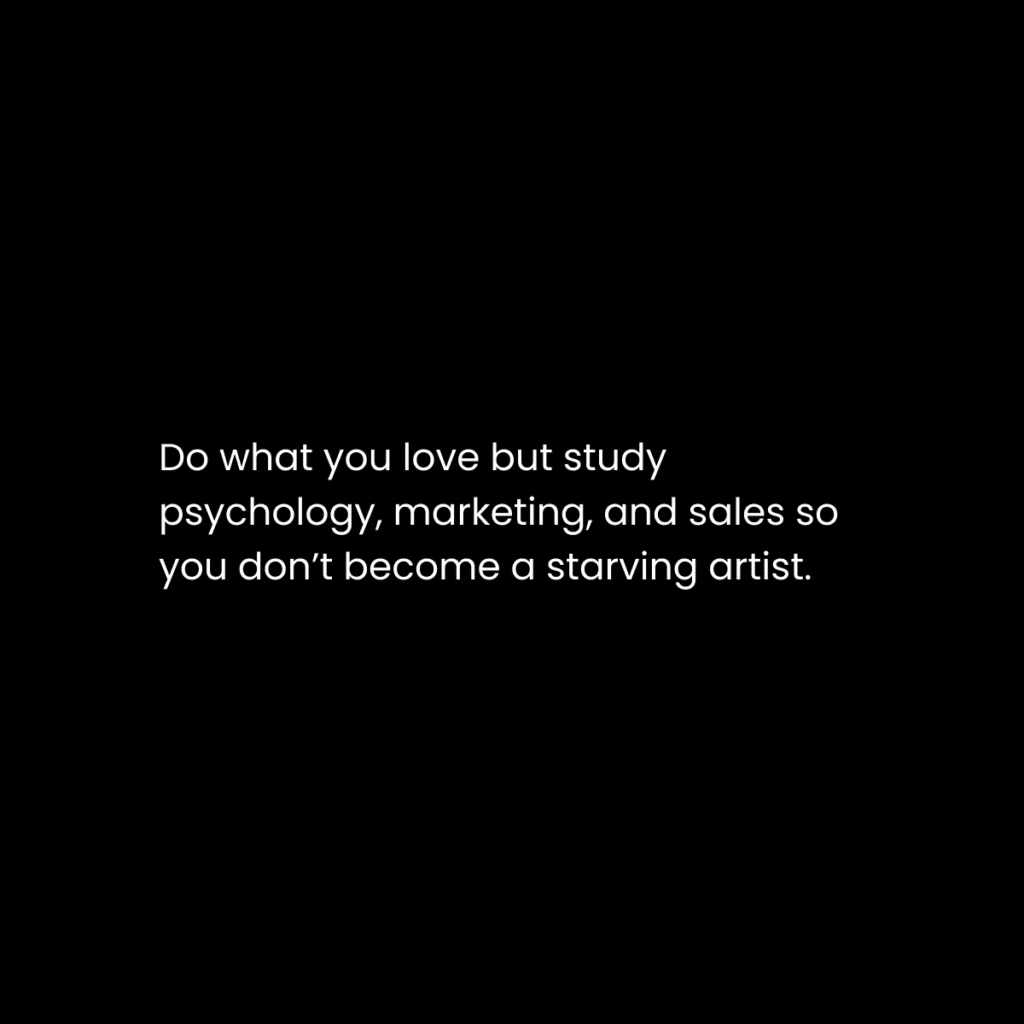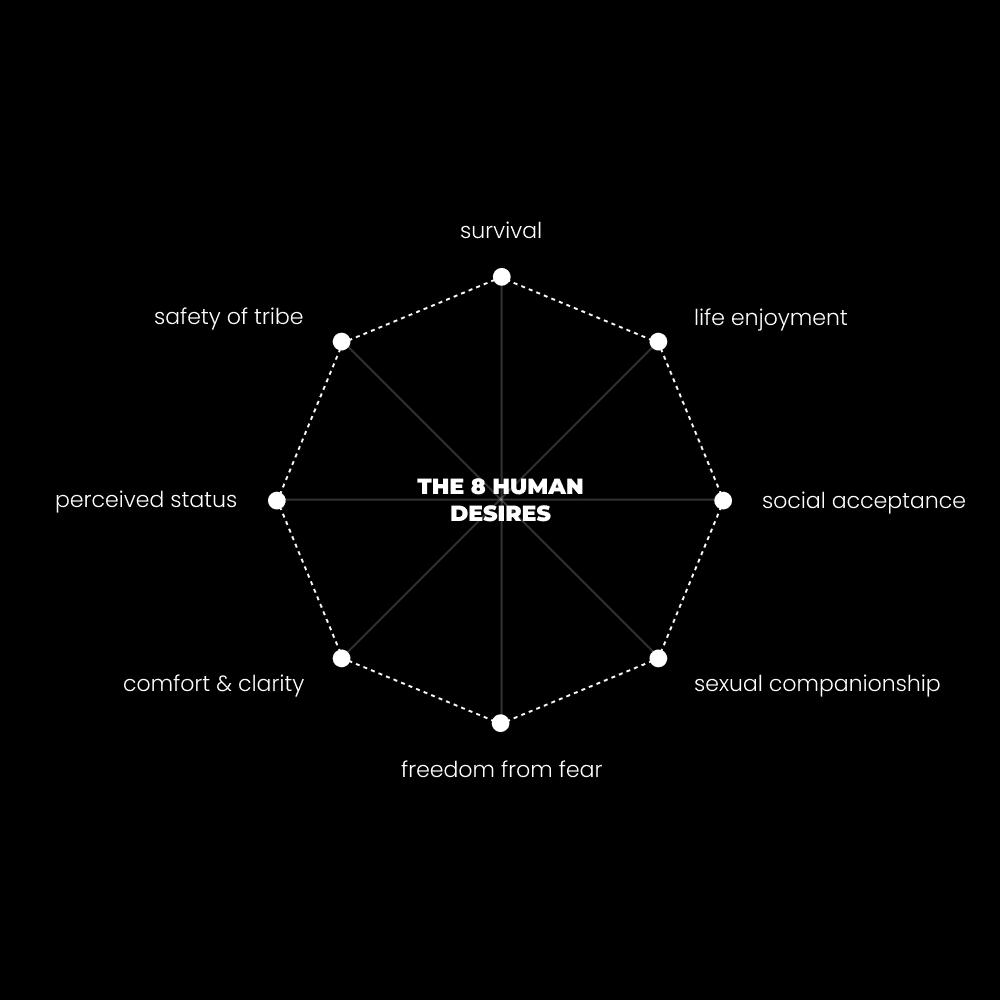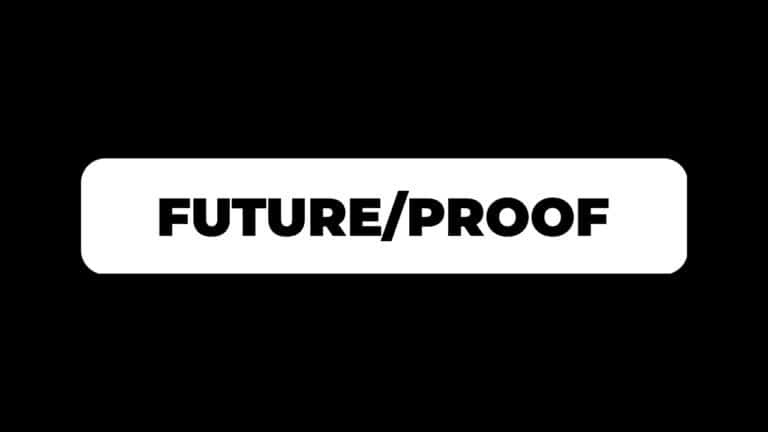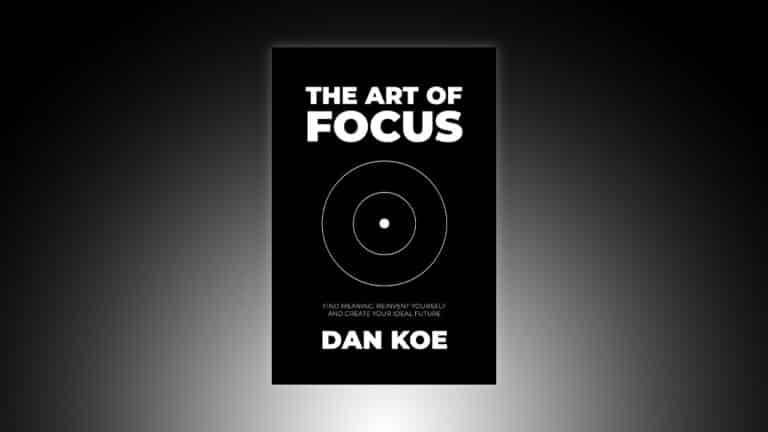One of my favorite failed businesses was creating digital art with photoshop.
Here’s one of my favorite pieces (you can find them all if you scroll ALL the way to the bottom of my Instagram).

This endeavor was the first time I realized the power of social media.
I emulated how larger accounts grew their following by:
- Tagging community pages that share digital art
- Creating the best composites I could so they would get shared
- Remixed photographers’ images in hopes that they would share my content (like mentioning a large account in a Twitter thread so they retweet to their audience)
This was almost 5 years ago and was how I gained my first 2,500 followers on Instagram.
After 3 months of locking myself in my room, forgetting to eat, and pouring my heart into my creations, I gave up.
I loved to create but had no idea how to monetize.
My art was valuable, but not valuable enough to demand payment.
It wasn’t even a possibility in my mind.
I realized that I couldn’t sustain my lifestyle as an artist.
I felt like I had to learn a more profitable skill to freelance with.
Of course, I was an idiot.
If I knew what I knew now, I would probably still be creating in photoshop.
I love writing a bit more now, so I don’t plan to go back to digital art, but if I could go back here’s what I would do:
- Continue growing and realize my audience is a traffic source
- Create a product or service to send that traffic to (courses and coaching in this case)
- Learn copywriting, marketing, and offer creation to position my product in the market
- Partner with personal development creators to visualize their best ideas and become an authority in the space
In other words, I’d do everything we’ve talked about in the one-person business videos.
As with all of my failed businesses, they taught me a valuable lesson.
The skills, like photoshop, all contributed to the success of my current brand (i.e. I make all of my designs and thumbnails).
But there is one skill that I attribute 95% of my brand, sales, and audience growth over the years.
The Universal Pattern Of Human Psychology

Every “money-making” skill that people tell you to learn is linked with Universal patterns and human psychology.
If they aren’t, then they don’t make money.
And if they don’t make money, then you need to stack the skills that allow them to make money.
At the base of all human behavior (including people pulling out their credit cards to pay you) are three things:
1) Survival – the desire to replicate the information in your genes and consciousness, both physical and mental.
2) Evolution – the desire to outpace destruction through creation.
3) Transformation – the desire to achieve a higher quality of experience.
These are all fairly similar and can be considered synonymous for the rest of this letter.
Storytelling, games, music, and architecture can also be observed to dissect these patterns. The principles of each can be used to enhance the impact of your skill stack.
In the simplest way I can explain it, all of these use the same framework: purpose, path, priority.
1) Purpose
Behavior change starts with a problem and shines a light on a goal to overcome it.
Goal = purpose.
Purpose = desire.
Desire = how problems come into existence.
Like how a story opens a curiosity loop by illustrating or implying a problem.
Or how a landing page targets a relevant problem in your life to incentivize action.
Or how you get fed up with a problem in your life and finally decide to solve it.
By shining a light on a problem in someone’s life, you create purpose.
2) Path
When a problem is identified and an accompanying goal reveals a potential future, clarity is the bridge.
The opposite of clarity is chaos, and we don’t want our customers anxious and overwhelmed at the thought of using our product.
3) Priority
In order for the problem to register in one’s awareness it must be important to them.
And if the problem isn’t important to them, you won’t catch their attention to show them the path. The path won’t even matter at that point because it won’t help them, nor will they have the drive to act.
Importance is subjective.
Humans perceive problems from the lens of their identity.
If you are trying to sell a self-improvement product to an overweight gamer, you have to position that product in a very specific way.
By the way, this is the same framework you can use to take back control of your life.
The Value Creation Framework
The purpose > path > priority framework is great, but let’s make it practical.
In the next section, we will discuss where we can use these things.
Consider all of the parts below as “marketing firepower” that you can use in your content, promotions, or even language in everyday life to illustrate the value of your product or yourself.
These are the steps to turning dirt into gold.
These are the steps that, when applied to any of my endeavors, led to my business making $1M.
These are the steps to practicing the most valuable skill which is value creation.
If you don’t have an offer, learn how to create one here, or how to package up the knowledge in your head here.
These will get easier with time.
Don’t worry if you struggle to fill these all out.
1) Levels Of Awareness
Everyone that you come across online and offline falls within a level of awareness (or consciousness) around their problems and your value (product, service, or being).
Note that these overlap with stages of ego development or the spiral dynamics scale in psychology / philosophy.
Level 1: Unaware
If you want to write viral tweets or create viral YouTube videos, base your content around the unaware stage.
In this stage, people are unaware of their problem and your offer.
You want to write and speak to make them aware of their problem and how it is impacting their life.
Educate, inform, and empathize with your readers with the problem they are facing.
If you are trying to help someone get fit, you may point out that a lack of proper nutrition is the source of their grogginess.
A tweet I would write:
“You are always tired because you stuff your face with hot pockets, Uber eats, and foods that lead to nutrient deficiency.”
A bit harsh, yes, but that’s my style.
Level 2: Problem Aware
Your readers are aware of a problem but may not understand it or know of a solution.
A post I would write:
“If you’re tired all the time:
– Weigh yourself every morning
– Eat your bodyweight in protein
– Drink water until you pee clear
– Walk 10,000 steps a day
Thank me later when you feel so good that you hate the thought of ruining that feeling with junk food.”
In long-form content, you can both educate people on the problem they are facing and provide a solution.
With short form, like tweets or shorts, you usually target levels 1-3 for maximum effect. Don’t be too high-level or clever.
Level 3: Solution Aware
At this stage people are aware of their problem and that a solution exists. But they don’t know your solution exists.
Now you are giving a clear solution or encouraging them to act.
Level 4: Product Aware
People are aware of your solution and other similar solutions.
Your job is to present reasons as to why yours is better.
Benefits-rich language is key.
Here’s a post I would write:
“Why you should start intermittent fasting:
– Morning focus is insane
– You don’t have to plan morning food
– Lunch and dinner can be massive meals”
I could finish the post but you get the point, and this is already getting long.
Level 5: Most Aware
People are brutally aware of your solution and need a little push over the edge.
You can either continue promoting your product until the time is right (like retargeting ads, people usually don’t buy when they first see your product)…
Or you can offer a limited-time sale or implement another scarcity tactic. Use this sparingly.
2) Positioning

Now that we understand the levels of awareness, we can begin to craft a persuasive message.
By the way, I give you Notion templates and in-depth education on how to create and sell a product from the knowledge in your brain in Digital Economics.
We’ve discussed the eternal markets many times before (health, wealth, relationships), but we are taking it deeper.
There are 8 human desires that are impossible to ignore.
All of your content, sales pages, or writing should be written from the lens of these desires:
- Survival
- Life Enjoyment
- Freedom From Fear
- Sexual Companionship
- Comfort & Clarity
- Perceived Status
- Safety Of Community
- Social Acceptance
Educate people on the problems standing in the way of these desires and provide a solution to overcome them.
Notice how every single person’s “niche” is self-actualization.
My business philosophy that is:
Solve your own problems > document the solution > improve others to raise the collective consciousness still holds true.
3) Big Problem
From a specific level of awareness and angle you choose to position from, you identify a big problem to begin your writing, speaking, or creations.
From the “unaware” stage and “perceived status” angle, I can identify a big problem like:
Not being able to get a 6 figure job.
I can then agitate that problem and illustrate how not having a 6 figure job is impacting their dating, ability to pay the bills, and how the world naturally lacks a level of respect for them.
You can also see how that problem hits from other angles like “survival.”
Shallow?
Yes.
Welcome to human life.
Depth comes after you solve shallow problems in your life (and others).
Nobody cares about mindfulness or existentialism if the problem that occupies the entirety of their mind is paying the bills or having sex.
There are stages of development that we must raise people up.
4) Unique Mechanism
You need a solution that stands out from everyone elses.
Again, this is why I recommend “figuring it out” for yourself, because you create a unique solution through experimentation.
Like how Greg O Gallagher combined intermittent fasting and reverse pyramid training into a fitness program that fits his specific lifestyle.
Then, he targeted problems within his lifestyle, positioned them toward the 8 human desires, and sold his unique solution.
Think about how you would solve the problem, step by step, and slap a compelling name on those steps.
My 2-Hour Content Ecosystem is an example.
5) Bullet Spray Benefits
I love overwhelming people with benefits in my copywriting and tweets.
When you give a bullet point list of hard-hitting benefits of your unique solution, you give people multiple reasons to buy (or engage).
Even if one point doesn’t resonate, another may be the reason they convert.
6) Proof
Personal results, testimonials, and any other statistics or facts you can gather will help people trust that you can deliver results.
Don’t underestimate the power of personal experience. It’s something that we rarely see. People crave human connection.
This is why I start 90% of my newsletters and videos with a personal experience that illustrates a problem I was having.
Of course, testimonials are powerful, and you should make it your full-time job to acquire them at the beginning, but you shouldn’t wait until you have them to start selling.
7) Big Idea
After you’ve fleshed out the other value creation points, you want to mull over them all to get to the big idea.
The big idea is somewhat of a one-sentence summary that illustrates your value.
Most popular quotes are big ideas.
The content that sticks in your head is big ideas.
Big ideas are best found by hunting for them and making them your own.
Bitcoin is the digital currency of the future.
Uber is the modern taxi service.
ChatGPT is f**king everything.
This can overlap with or be any of the points you listed, as long as it’s potent.
It took a while for this to make sense to me, and I’m still unable to articulate it.
Understand it through practice and struggle.
Or, you can hunt for big ideas with last weeks letter.
8) Risk Reversal & End Result
A compelling risk reversal will help you close deals at the beginning of your journey.
Most people opt for a money-back guarantee, which is cool, but you can make it juicier by pairing it with a clear end result.
Example when selling a dating product:
“If you don’t land 5 dates in 60 days we refund your investment.”
Who wouldn’t buy that?
And it puts pressure on you to deliver.
You will have to add caveats to your risk reversal and state that they must act on everything you provide.
Marketing Legos
Treat everything above as “marketing legos” for anything you write about, speak about, or interact with another human being about.
Everything.
You have to practice this every moment you can if you want to get good.
Reading this post is not enough.
Reading anything is not enough.
You have to start a project, encounter real-world problems, and let reality teach you what reading can’t.
There are thousands of minor nuances that no single person can illustrate to you in a piece of content, book, or course.
You have to pick them up, consciously and subconsciously, through action.
Here are a few places you can start practicing your value creation:
Social Media Posts
Engaging long-form content follows this format:
- Introduce a problem and agitate it
- Give context or raise them to the solution-aware level (usually through proof or a story)
- Give actionable steps to overcome the problem (and preferably name that method as your own)
- Incorporate the benefits of implementing that system so people act
- Use the big idea of your content as the title or headline
The One Person Business that I talk about so much is both a validated big idea and unique mechanism to many big problems in life.
Long-form content can walk people through all levels of awareness.
For engagement, target 1-3.
For sales, target 2-5.
For hard promotions, target 3-5.
This applies to newsletters, threads, carousels, captions, and YouTube videos.
Short-form content is limited to one at a time.
You can turn any of your “marketing legos” into a post.
This applies to tweets, single IG posts, tiktoks and shorts, etc.
Landing Pages & Sales Pages
Similar to writing long-form content, landing and sales pages follow the same pattern.
If you want to practice with copywriting frameworks, use:
- PASTOR – problem, amplify, story, testimony, offer, response
- AIDA – attention, interest, desire, action
- PAS – problem, amplify, solution
And get better with time.
For your headline and subheadline, you are trying to fit most, if not all, of your marketing legos into them.
This also applies to sales calls, DMs, or presentations.
Course Curriculum
You want people to act on the content you teach.
You don’t stop being persuasive after they buy your product.
You have to hold their attention, give them clarity, and encourage them to act.
How else are they going to get results?
And if they don’t get results, how are you going to get testimonials?
Everyday Conversation
All human communication is persuasive.
When you converse with someone, you attempt to operate from a shared perspective.
When you don’t, that’s when arguments start.
A perspective has a shared goal, so start the conversation with a problem to catch their attention.
You: “Man I’ve felt so tired lately, I can’t get any work done.”
Them: “Same man I’m always tired.”
You: “Yeah last time I felt like this I got deep into fitness, I’m going to get back on my routine.”
Them: “What was the routine?”
You: “I followed the vertical diet and bro split in the gym.”
The conversation would go on to hopefully educate them on what you are doing and give them something useful to try (and the benefits of doing so).
That conversation is valuable (and can be turned into content ;))
That’s it.
Go out and start practicing in everything you do.
Your articulation, cash flow, and quality of life will go through the roof.
– Dan Koe



